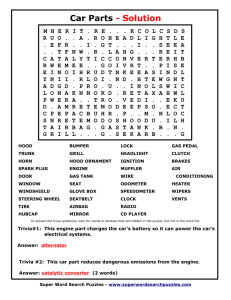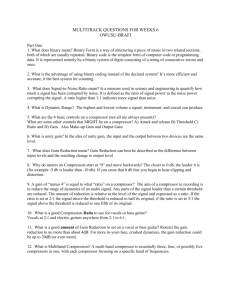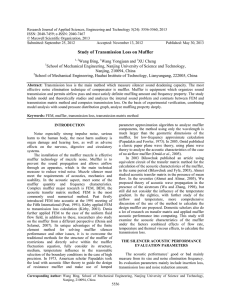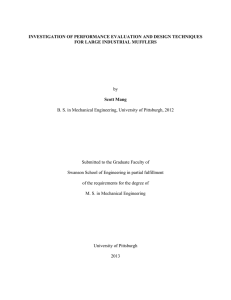Noise Reduction in a Reciprocating Compressor by Optimizing the Suction Muffler
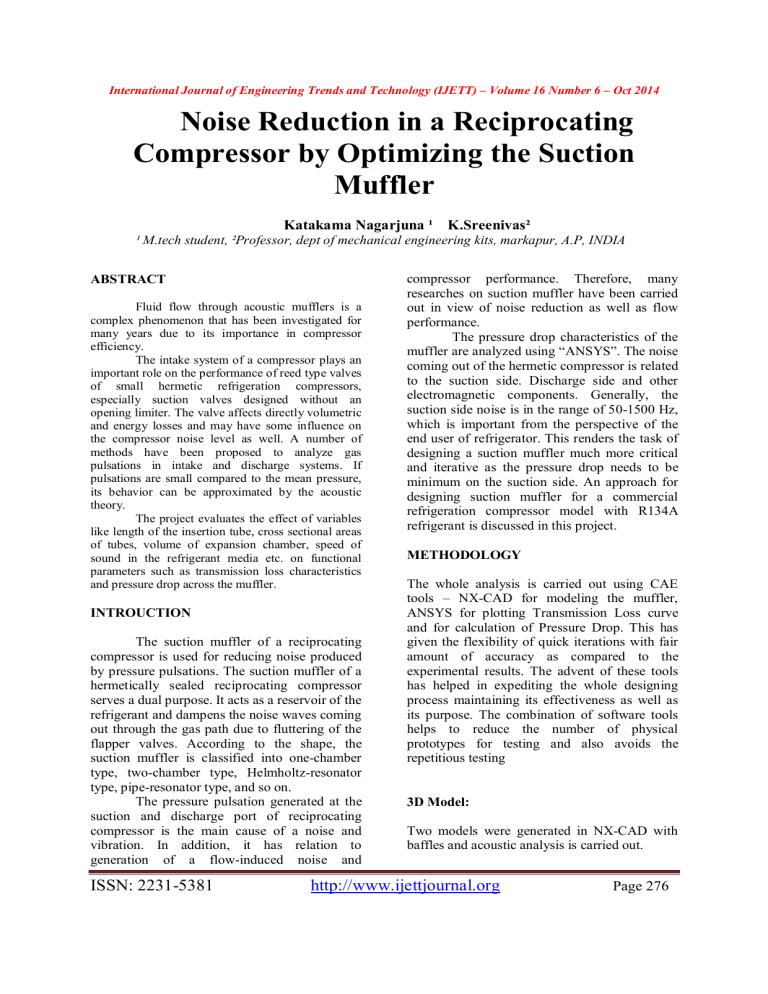
International Journal of Engineering Trends and Technology (IJETT) – Volume 16 Number 6 – Oct 2014
Noise Reduction in a Reciprocating
Compressor by Optimizing the Suction
Muffler
Katakama Nagarjuna ¹ K.Sreenivas²
¹ M.tech student, ²Professor, dept of mechanical engineering kits, markapur, A.P, INDIA
ABSTRACT
Fluid flow through acoustic mufflers is a complex phenomenon that has been investigated for many years due to its importance in compressor efficiency.
The intake system of a compressor plays an important role on the performance of reed type valves of small hermetic refrigeration compressors, especially suction valves designed without an opening limiter. The valve affects directly volumetric and energy losses and may have some influence on the compressor noise level as well. A number of methods have been proposed to analyze gas pulsations in intake and discharge systems. If pulsations are small compared to the mean pressure, its behavior can be approximated by the acoustic theory.
The project evaluates the effect of variables like length of the insertion tube, cross sectional areas of tubes, volume of expansion chamber, speed of sound in the refrigerant media etc. on functional parameters such as transmission loss characteristics and pressure drop across the muffler.
INTROUCTION
The suction muffler of a reciprocating compressor is used for reducing noise produced by pressure pulsations. The suction muffler of a hermetically sealed reciprocating compressor serves a dual purpose. It acts as a reservoir of the refrigerant and dampens the noise waves coming out through the gas path due to fluttering of the flapper valves. According to the shape, the suction muffler is classified into one-chamber type, two-chamber type, Helmholtz-resonator type, pipe-resonator type, and so on.
The pressure pulsation generated at the suction and discharge port of reciprocating compressor is the main cause of a noise and vibration. In addition, it has relation to generation of a flow-induced noise and compressor performance. Therefore, many researches on suction muffler have been carried out in view of noise reduction as well as flow performance.
The pressure drop characteristics of the muffler are analyzed using “ANSYS”. The noise coming out of the hermetic compressor is related to the suction side. Discharge side and other electromagnetic components. Generally, the suction side noise is in the range of 50-1500 Hz, which is important from the perspective of the end user of refrigerator. This renders the task of designing a suction muffler much more critical and iterative as the pressure drop needs to be minimum on the suction side. An approach for designing suction muffler for a commercial refrigeration compressor model with R134A refrigerant is discussed in this project.
METHODOLOGY
The whole analysis is carried out using CAE tools – NX-CAD for modeling the muffler,
ANSYS for plotting Transmission Loss curve and for calculation of Pressure Drop. This has given the flexibility of quick iterations with fair amount of accuracy as compared to the experimental results. The advent of these tools has helped in expediting the whole designing process maintaining its effectiveness as well as its purpose. The combination of software tools helps to reduce the number of physical prototypes for testing and also avoids the repetitious testing
3D Model:
Two models were generated in NX-CAD with baffles and acoustic analysis is carried out.
ISSN: 2231-5381 http://www.ijettjournal.org
Page 276
International Journal of Engineering Trends and Technology (IJETT) – Volume 16 Number 6 – Oct 2014
Trial1:
Fig 1: The geometric model without baffle used for acoustic analysis
Inputs and material properties:
Refrigerant:
Refrigerant is a substance which has the capacity to absorb heat from any other substance. Refrigerant absorbs heat from source and dissipate heat to sink either in the form of
Latent heat or Sensible heat.
Ideal refrigerant:
Ideal Refrigerant should have good chemical, Physical and thermodynamic properties and in addition to above it should be non-toxic, non-flammable, completely stable inside the system, easily available and environmentally friendly.
Properties of Refrigerant:
Chemical Properties
Flammability
Toxicity
Reaction with material
Damage to refrigerated products
Physical properties
Leak tendency and detection
Viscosity
Thermal conductivity
Reaction with oil
Cost
Refrigerant is taken as R-134A in our analysis.
The material properties are as given below
Material properties at inlet (material 1)
Density of fluid = 21.51 kg/m3
Velocity of sound (c) =180.3 m/sec
Material properties at outlet (material 2)
Density of fluid = 21.51 kg/m3
Density of fluid = 21.51 kg/m3
Absorption of sound at the interface is accounted for by generating a damping matrix using the surface area and boundary admittance at the interface. Experimentally measured values of the boundary admittance for the sound absorbing material may be input as material property MU. Ansys recommend MU values from 0.0 to 1.0; however, values greater than 1.0 are allowed. MU = 0.0 represents no sound absorption and MU = 1.0 represents full sound absorption. DENS, SONC and MU are evaluated at the average of the nodal temperatures.
In our analysis we have taken Admittance = 1
Impedance = density*sonic velocity
= 21.51*180.3
= 3875.253 kg/m2-sec
ISSN: 2231-5381 http://www.ijettjournal.org
Page 277
International Journal of Engineering Trends and Technology (IJETT) – Volume 16 Number 6 – Oct 2014
Finite Element Model:
Fig 2: Finite element model meshed using fluid
30 element for acoustic analysis
The acoustic pressure in the fluid medium is determined by the wave equation with the following assumptions:
The fluid is compressible (density changes due to pressure variations).
In viscid fluid (no dissipative effect due to viscosity).
There is no mean flow of the fluid.
The mean density and pressure are uniform throughout the fluid. Note that the acoustic pressure is the excess pressure from the mean pressure.
Analyses are limited to relatively small acoustic pressures so that the changes in density are small compared with the mean density.
Boundary conditions:
A unit pressure dof is applied at the acoustic inlet of the suction muffler and the same is useful to determine the pressure drop.
Impedance value of 3825kg/m2-sec is applied at acoustic outlet of the suction muffler.
Boundary admittance of 1 for the sound absorbing material is applied on the acoustic outlet
Fig 3: Various boundary conditions applied for the acoustic analysis
Acoustic Analysis:
Results obtained after performing acoustic analysis
Pressure plot:
The below figure is the plot of the contours of pressure drop across the inlet and outlet. The pressure drop is noted as 0.132. This value is used for validation of other two suction mufflers
Fig 4: The contour plot of the pressure drop
Transmission Loss:
Acoustic analysis is done in the frequency range of 0-1200Hz to find the transmission loss at various frequencies.
Transmission loss through the muffler is the difference between the power incident on the muffler and the power transmitted through it.
+ve transmission loss indicates sound
Attenuation and –ve transmission loss indicates sound amplification
ISSN: 2231-5381 http://www.ijettjournal.org
Page 278
International Journal of Engineering Trends and Technology (IJETT) – Volume 16 Number 6 – Oct 2014
Attenuation of the sound is the reduction of acoustic energy from entrance to the exit of the muffler tube.
In acoustic analysis the Y-axis shows the transmission loss, + ve value indicates sound attenuation where – ve indicates amplification
From the below figures it is observed that transmission loss is _ve at a frequency of
150Hz that the noise level peaks between 80-140Hz & at 1000Hz. These results are used for further validation.
The objective of this project is to optimize the above muffler to increase transmission loss the at the above said frequencies. In this case, noise can be reduced so much in a local frequency band, but the width of the band is too narrow to reduce the noise totally with varying temperature of the refrigerant. On the other hand, it is reported that a suction muffler with a pipe resonator can reduce noises efficiently in a broad frequency band. So a pipe resonator which we term here as
‘Baffle’ is used in this analysis. Two of such baffles are developed with number iterations.
Trial2:
A baffle with the below dimensions is inserted into the existing suction muffler and acoustic analysis is carried out to determine the transmission loss and the pressure drop.
MUFFLER WITH THE BAFFLE :
Fig 5: The transmission loss vs. frequency plot over a frequency range of 0-600Hz for trial 1 model
From the below figures it is observed that transmission loss is very less at a frequency of
1020Hz
Fig 6: The transmission loss vs. frequency plot over a frequency range of 600-1200Hz for trial 2 model
The above graphs are plotted as transmission loss versus frequency. It is noted
Fig 8: The modified model of suction muffler with baffle
Results obtained after carrying out acoustic analysis in the frequency range of 0-1200Hz
The below figure is the plot of the contours of pressure drop across the inlet and outlet. The pressure drop is noted as 0.618. This value is used for validation of other two suction mufflers.
ISSN: 2231-5381 http://www.ijettjournal.org
Page 279
International Journal of Engineering Trends and Technology (IJETT) – Volume 16 Number 6 – Oct 2014
Fig 9: Contour plot of pressure drop
Transmission Loss:
From the below figures it is observed that transmission loss is -ve at a frequency of 80Hz and 280Hz
Transmission loss is plotted against frequency. It is noted that the transmission losses are increased with the introduction of the baffle resulting in reduced noise levels.
From the above results it can be concluded that the transmission loss has increased over the frequency range of 300-
1200Hz compared to trial1 which indicates the elimination of noise problem over this frequency range. Pressure drop is increased from 0.132 units in trial 1 to 0.618 in trial 2 which may result in less efficiency of the muffler.
So to increase the efficiency of the muffler efforts are put to modify the baffle dimensions so as to decrease the pressure drop.
A modified baffle is inserted into the suction muffler and acoustic analysis was carried out to determine pressure drop and transmission loss.
Trial 3:
MUFFLER WITH MODIFIED BAFFLE:
Fig 10: Transmission loss vs. frequency plot over a frequency range of 0-600Hz for trial 2 model
From the below figures it is observed that transmission loss is +ve over a frequency range of 600 -1200Hz
Fig 11: Transmission loss vs. frequency plot over a frequency range of 600-1200Hz for trial 2 model
Fig 12: Muffler with modified baffle
The muffler baffle dimensions are as listed below:
INLET COMPARTMENT:
Baffle tube diameter at the inlet= 6mm
Length of the baffle tube = 10.1 mm
OUTLET COMPARTMENT:
Baffle tube diameter at outlet= 9mm
ISSN: 2231-5381 http://www.ijettjournal.org
Page 280
International Journal of Engineering Trends and Technology (IJETT) – Volume 16 Number 6 – Oct 2014
Length of the baffle tube = 14.2 mm
Results obtained after carrying out acoustic analysis in the frequency range of 0-1200Hz
From the below figure it can be seen that the maximum pressure drop is 0.245units]
Fig 13: Contour plot of pressure drop.
The pressure drop value is 0.245199 which is almost near as the trial1 (0.134) and less than that of case2.
Transmission Loss:
From the below figures it is observed that transmission loss is _ve at a frequency of 130Hz and 310Hz
Fig 14: Transmission loss vs. frequency plot over a frequency range of 0-1200Hz for trial 3 model.
The above graph indicates the transmission loss versus frequency curve. It is noted that by introducing the modified baffle into the suction muffler, the transmission losses are dramatically increased over a wide frequency range.
CONCLUSION
After the initial run for the same flow and acoustic boundary conditions the Trial-3 muffler model looks better than other combinations, which further need to be analyzed for reversible flow and its effect.
Discussion on the Transmission loss-TL
Results:
1. As can be seen from the graphs for Trial1 to
Trial 3, the insertion of baffle has considerable effect on the magnitude of transmission loss.
2. Increase in the length of the baffle gives more pressure drop and decreasing the efficiency of the muffler.
3. Decrease in the insertion length of baffle tube gives better magnitude of transmission loss in higher frequency range with marginal decrease in performance in the lower frequency range.
The results show us that the Trial3 muffler gives us the best results from the parameter analysis. The transmission loss characteristics of the muffler are as per the requirement. The muffler is further checked for the pressure drop characteristics to see the effect of the muffler on the compressor performance.
These values are used to find the pressure drop across the muffler. This pressure drop is used in the equations of compressor performance.
Assumptions made for the analysis:
1. The sound pressures inside the muffler are small compared to the overall level of pressure inside the system.
2. Only plane waves of pressure are considered.
(Imaginary/Complex waves are not considered.)
3. Viscosity effects of the fluid are neglected
(The medium is in viscid and stationary).
4. The tailpipe of the muffler has its characteristic impedance value (ρ X C) i.e. it will act as a perfect absorber.
ISSN: 2231-5381 http://www.ijettjournal.org
Page 281
International Journal of Engineering Trends and Technology (IJETT) – Volume 16 Number 6 – Oct 2014
Method of plotting Transmission Loss curve in ANSYS:
1. Each Trial was analyzed in ANSYS for
Transmission Loss Curve. These TL curves were analyzed for the required criterion. As seen from
Figure 2, Trial3 has the best TL curve.
2. The response curves and the interaction effects plotted for Trial3.
3. The optimized combination of parameters were derived and then analyzed for the pressure drop in ANSYS.
REFERENCES
1. Singh, R. and Soedel, W., “A Review of Compressor Lines
Pulsation Analysis and Muffler Design Research Part I – Pulsation
Effects and Muffler Criteria,” International Compressor
Engineering Conference at Purdue, pp112-123, 1974.
2. Singh, R. and Katra, T., “On The Dynamic Analysis and
Evaluation of Compressor Mufflers,” International Compressor
Engineering Conference at Purdue, pp372-381, 1976.
3. Koai, K. L., Yang, T. and Chen, J., “The Muffling Effect of
Helmholtz Resonator Attachments to A Gas Flow Path,”
International Compressor Engineering Conference at Purdue, pp793-798, 1996.
4.Kinsler, L. E., Frey, A. R., Coppens, A. B, and Sanders, J. V.,
“Fundamentals of Acoustics,” John Wiley & Sons,Inc., 1982.
5.Bassi, F., Pelagalli, L., Rebay, S., Betto, A., Orefice, M., Pinto,
A., “Numerical Simulation of a Reciprocating Compressor for
Household Refrigerators”, Proc. Compressor Engineering
Conference at Purdue, West Lafayette, Indiana, USA, p. 97-104,
2000.
6.Choi, J.K., Joo, J.M., Oh, S.K., Park, S.W., “Smart Suction
Muffler Design for a Reciprocating Compressor”, Proc.
Compressor Engineering Conference at Purdue, West Lafayette,
Indiana, USA, p.619-626, 2000.
ISSN: 2231-5381 http://www.ijettjournal.org
Page 282


